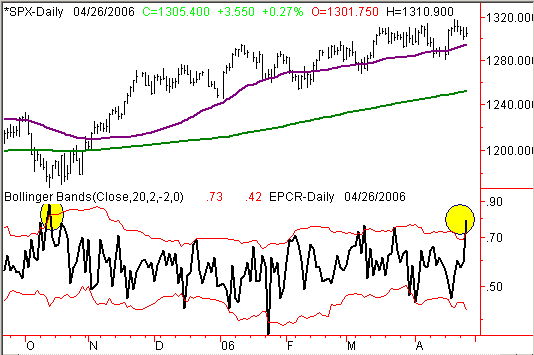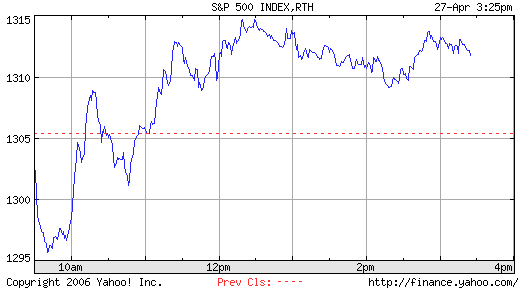At close Wednesday, we saw a spike in the EPCR. This was no average spike. It was the highest move above the 20-day bands that we'd seen since October of 2005. That was a major turning point in the market. From there, the market has rallied over 10%. You can see Wednesday's spike below. I knew this might be a significant buying opportunity for the market. Market futures were down about half a percentage point, which is a significant gap down from previous day's close. The only significant piece of news this morning was unemployment data, which was worst than expected, but still not bad enough to warrant such a large gap down in the market.
I believe that the large gap down in the morning was due to overly fearful market sentiment ahead of chief Bernanke's testimony. This coincided very well with the fear spike in the EPCR, and I knew it was time to pull the trigger. EPCR fear spikes have tested very well in the past.
SPX and EPCR Spikes

SPY Minute Chart

The Key to Making Money
I was chatting with a co-worker the other day and we were talking about industry research. He said that industries are easy to pick and if you can just time the market, you will make money. I thought about it and he happens to be mostly right. When you are dealing with large cap stocks, timing the market is a very big deal. It's been said that a rising tide lifts all boats. In other words, a rising market can lift even the worst large cap stocks. Since we specialize in options, large caps are of particular interest to us, since we focus on high-volume options. What sort of tools can the average man use to time the market? Today, we will discuss the Chicago Board of Exchange Total Equity Put/Call ratio. In doing so, we hope to give you another tool to time the market.
The EPCR
The Chicago Board of Exchange Total Equity Put/Call ratio (EPCR) is the sum of all puts traded on any given day divided by the total number of calls traded that same day. Most of the time, the ratio is less than one. A ratio of more than one would indicate that more puts were traded on a day than calls. The EPCR is an excellent measure of market sentiment. Basically, when the there is an unusually high amount of puts bought, this indicates bearishness amongst option buyers. When there is an unusually large amount of calls being bought, it indicates bullishness by option buyers. We view any extreme reading as an indicator to buy or sell. For example, if there is unusually high bearishness (like there was Wednesday) we view that as a overly bearish and we tend to be bullish. The opposite is true of overly bullish readings.
The best way to trade this concept is not to look at predetermined numbers on the EPCR reading such as .50 or 1.00 for bearishness or bullishness. The best way to trade this strategy is to plot 20 or 21-day Bollinger bands around the EPCR. This way, you can easily see extreme readings. Another benefit of Bollinger bands is that they adapt to current market conditions. When the readings for the past 21 days have been very volatile, the bands expand to compensate. When there is a period of extremely low volatility, the bands contract. This way, you can easily see when high or low reading occurs because it is all relative to what has happened recently.
Specific Trade Instructions
There are many ways to trade this strategy including the use of moving averages and bearish signals as well as bullish signals. We will be talking about only one way to trade this indicator.
Use 21-day Bollinger Bands around the EPCR. Buy the market when you see a close above the 21-day bands. Hold the trade for 15 days. Sell before 15 trading days if you see a reading below the lower band. All of these signals will be available as of the close of market. You can put your orders in at open the next day. This system is was profitable 74% of the time from 1990 to 2000. Lately, the system's effectiveness has retracted somewhat. It is wise to take into consideration other factors when trading this strategy and not to rely on it alone. Be disciplined and trade well.
Price Headley is the founder and chief analyst of BigTrends.com.